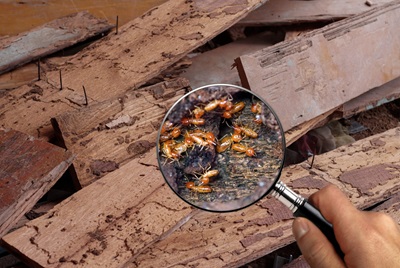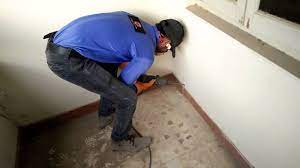Termite Treatment For Walls - Complete Procedure
Have you ever tapped your wall and heard a hollow echo that sent shivers down your spine? It might sound like something out of a horror movie, but for many homeowners, that unsettling sound is a sign of a very real nightmare - termites.
These tiny, wood-chomping insects can silently devour your walls from the inside out, causing thousands of dollars in damage before you even know they're there.
But fear not, brave homeowner! This guide will equip you with the knowledge to fight back. We'll explore the telltale signs of a termite infestation, delve into the different treatment options available, and help you choose the best course of action to save your home from these destructive pests.
The Termite Problem: Understanding the Threat to Your Home
What are Termites?
Termites are social insects that feed on wood and other cellulose-based materials. They are often referred to as "silent destroyers" because they can cause significant damage to homes without being noticed until it's too late.
Types of Termites That Target Homes
- Subterranean Termites: These termites live in underground colonies and build mud tubes to reach wood above ground. They are the most common type of termite and can cause significant damage to homes.
- Drywood Termites: These termites live in wood and do not require contact with soil. They are less common than subterranean termites but can still cause significant damage to homes.
Signs of Infestation
- Mud Tubes: Mud tubes are a common sign of termite infestation. These tubes are made of soil and feces and are used by termites to travel between their underground colonies and the wood they are feeding on.
- Frass Piles: Frass piles are a sign of termite infestation and are formed when termites discard their waste. These piles can be found near the site of termite activity.
- Hollow-Sounding Wood: When termites eat away at wood, it can cause the wood to become hollow. When tapped, hollow-sounding wood can indicate the presence of termites.
How Termites Enter Walls and Cause Damage
Termites enter walls through various means, including:
- Cracks and Crevices: Termites can enter walls through small cracks and crevices in the foundation, walls, or roof of a building. These openings can be as small as a paper clip, allowing termites to squeeze through and establish a colony.
- Wood-to-wood Contact: Termites can also enter walls through wood-to-wood contact, such as where two pieces of wood meet or where a wood beam meets a wall. This can occur even if the wood is treated with chemicals or other forms of termite protection.
- Moisture: Termites thrive in moist environments, so they are attracted to areas with high humidity or water damage. This can include areas around sinks, dishwashers, and other appliances that produce moisture.
- Food Sources: Termites are attracted to food sources such as wood, paper, and other cellulose-based materials. They can enter walls through areas where these materials are present, such as near a wood stove or fireplace.
Causes of Termite Damage
Once termites enter a wall, they can cause significant damage by consuming wood and other cellulose-based materials. This damage can lead to structural issues, including:
- Wood Rot: Termites can cause wood to rot and decay, leading to structural weaknesses and potential collapse.
- Warping and Warping: As termites consume wood, it can warp and warp, causing doors and windows to stick or become difficult to open.
- Electrical and Plumbing Issues: Termite damage can also cause electrical and plumbing issues by compromising the integrity of walls and other structural elements.
Home Remedy For Termites In Walls
Termite treatment for walls - home remedies provide natural and effective ways to address termite infestations in walls without the use of termite chemicals. Remember to apply these remedies consistently and thoroughly to achieve the best results.To treat termites in walls using home remedies, you can consider the following effective methods:
- Vinegar and Lemon Solution: Create a mixture of white vinegar and lemon juice in a spray bottle. Spray this solution on areas where termites might be hiding in your wall.
- Sodium Borate or Borax: Directly apply borax or sodium borate powder on the termites visible on your walls. When termites come into contact with borax, they dehydrate and die.
- Aloe Vera: Use natural aloe vera gel on small areas infested with termites. When termites come in contact with aloe gel, they get coated and suffocate.
- Diatomaceous Earth: Sprinkle diatomaceous earth on wooden items and furniture to eliminate termites. This substance is abrasive and affects termites by targeting their nasal passages and lungs.
- Neem Oil: Apply natural neem oil on wooden structures to deter termites. Neem oil disrupts the reproductive system of termites and starves them to death.
- Orange Oil: A few drops of orange oil in termite-infested areas can act as a natural termite-killing solution. The compound in orange oil is intolerable to termites, leading to their demise.
- Petroleum Jelly: Petroleum jelly can be used as a natural termite-resistant product. It suffocates termites, offering a chemical-free solution.
- Saltwater Solution: Create a saltwater solution by mixing salt with water and spray it on termite-infested areas. Salt dehydrates termites, effectively repelling and killing them.
Professional Treatment Methods for Termite Control in Walls
Liquid Termiticide
One effective professional termite treatment method is using a liquid termiticide. This involves drilling holes in walls and injecting a termiticide solution into the walls and around the foundation. The termiticide creates a barrier that kills termites on contact and prevents further infestations.
Foam Termiticide
Another method for treating termites in walls is through the use of foam termiticide. This method involves using a foaming termiticide that expands to fill cracks and crevices where termites may be hiding. The foam effectively reaches areas that are difficult to access, ensuring thorough treatment and elimination of termites.
Bait Stations
Bait stations are a strategic termite control method that involves placing stations with slow-acting poison in key locations around the property. Termites are attracted to the bait, feed on it, and then carry it back to the colony, eventually leading to the elimination of the entire termite population. Bait stations are often used as part of a long-term termite control plan to monitor and manage termite activity.
Trenching and Treatment
Trenching and treatment is a proactive approach to termite control that involves digging trenches around the foundation of a building and applying a termiticide to create a protective barrier. This method helps prevent future termite infestations by creating a barrier that termites cannot easily cross. Trenching and treatment is a reliable method for long-term termite protection.
Preventing Future Termite Infestations
Moisture Control
Moisture control is crucial in preventing future infestations. Termites are attracted to damp environments, so addressing any moisture issues around the foundation of your home is key. Ensure proper drainage, fix leaks promptly, and consider using a dehumidifier in damp areas to keep termites at bay.
Regular Inspections
Scheduling regular inspections by a qualified pest control company is essential for early detection of any potential termite problems. These inspections can help identify issues before they escalate, allowing for timely intervention and prevention of infestations.
Eliminate Attractants
To prevent termites from being drawn to your home, it's important to eliminate attractants. This includes removing wood debris near the foundation, keeping firewood stored away from the house, and avoiding direct wood-to-soil contact. By removing these attractants, you can significantly reduce the risk of termite infestations.
Conclusion
Now you're armed with the knowledge to combat those creepy crawlies and protect your precious home. Remember, early detection is key. If you suspect a termite infestation, don't hesitate to take action. Schedule an inspection with a qualified pest control company for a professional diagnosis and treatment plan.
The National Pest Management Association is a great resource to find reputable pest control companies in your area.




